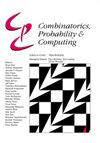Frozen (Δ + 1)-colourings of bounded degree graphs
IF 0.8
4区 数学
Q3 COMPUTER SCIENCE, THEORY & METHODS
引用次数: 4
Abstract
Let G be a graph on n vertices and with maximum degree Δ, and let k be an integer. The k-recolouring graph of G is the graph whose vertices are k-colourings of G and where two k-colourings are adjacent if they differ at exactly one vertex. It is well known that the k-recolouring graph is connected for $k\geq \Delta+2$ . Feghali, Johnson and Paulusma (J. Graph Theory83 (2016) 340–358) showed that the (Δ + 1)-recolouring graph is composed by a unique connected component of size at least 2 and (possibly many) isolated vertices.In this paper, we study the proportion of isolated vertices (also called frozen colourings) in the (Δ + 1)-recolouring graph. Our first contribution is to show that if G is connected, the proportion of frozen colourings of G is exponentially smaller in n than the total number of colourings. This motivates the use of the Glauber dynamics to approximate the number of (Δ + 1)-colourings of a graph. In contrast to the conjectured mixing time of O(nlog n) for $k\geq \Delta+2$ colours, we show that the mixing time of the Glauber dynamics for (Δ + 1)-colourings restricted to non-frozen colourings can be Ω(n2). Finally, we prove some results about the existence of graphs with large girth and frozen colourings, and study frozen colourings in random regular graphs.Frozen (Δ + 1)-有界度图的着色
设G是一个有n个顶点的最大度为Δ的图,设k是一个整数。G的k重着色图是这样一个图,它的顶点是G的k种着色,其中两个k种着色相邻,如果它们恰好在一个顶点上不同。众所周知,对于$k\geq \Delta+2$, k重着色图是连通的。Feghali, Johnson和Paulusma (J. Graph Theory83(2016) 340-358)表明(Δ + 1)重新着色的图是由一个大小至少为2的唯一连接组件和(可能有许多)孤立顶点组成的。本文研究了(Δ + 1)-重着色图中孤立顶点(也称为冻结着色)的比例。我们的第一个贡献是证明如果G是连通的,那么在n中G的冻结着色的比例指数小于着色的总数。这促使使用格劳伯动力学来近似图的(Δ + 1)颜色的数量。与$k\geq \Delta+2$色料的推测混合时间为O(nlog n)相反,我们证明了(Δ + 1)-色料的格劳伯动力学混合时间(限于非冷冻色料)为Ω(n2)。最后,我们证明了大周长图和冻结着色存在的一些结果,并研究了随机正则图中的冻结着色。
本文章由计算机程序翻译,如有差异,请以英文原文为准。
求助全文
约1分钟内获得全文
求助全文
来源期刊

Combinatorics, Probability & Computing
数学-计算机:理论方法
CiteScore
2.40
自引率
11.10%
发文量
33
审稿时长
6-12 weeks
期刊介绍:
Published bimonthly, Combinatorics, Probability & Computing is devoted to the three areas of combinatorics, probability theory and theoretical computer science. Topics covered include classical and algebraic graph theory, extremal set theory, matroid theory, probabilistic methods and random combinatorial structures; combinatorial probability and limit theorems for random combinatorial structures; the theory of algorithms (including complexity theory), randomised algorithms, probabilistic analysis of algorithms, computational learning theory and optimisation.
 求助内容:
求助内容: 应助结果提醒方式:
应助结果提醒方式:


